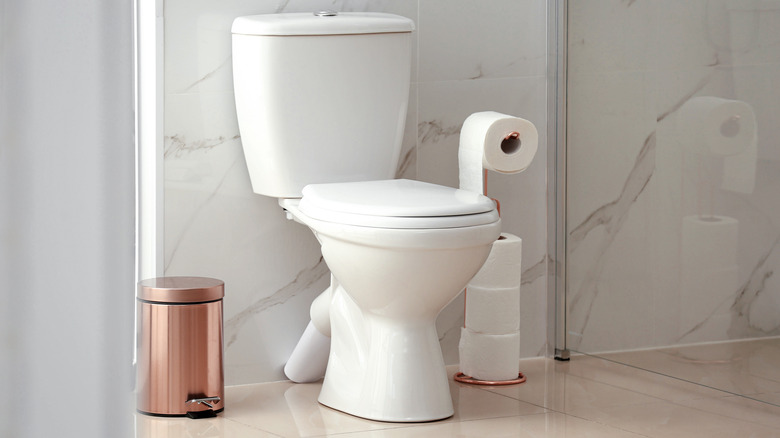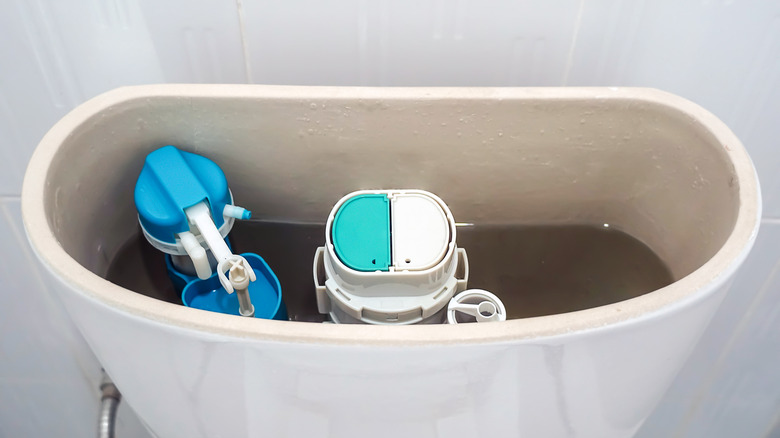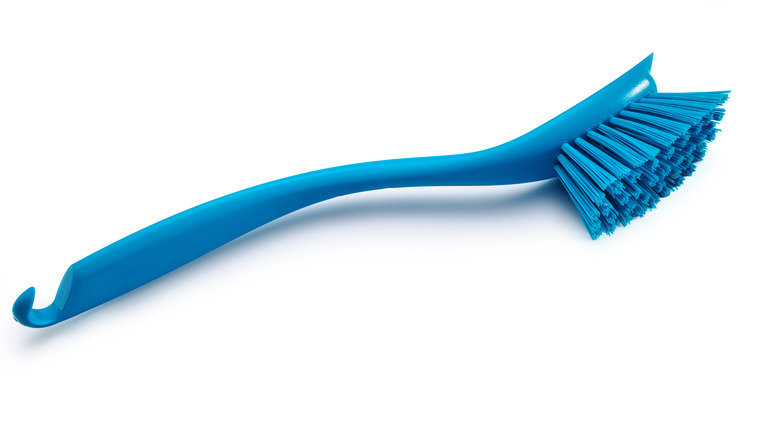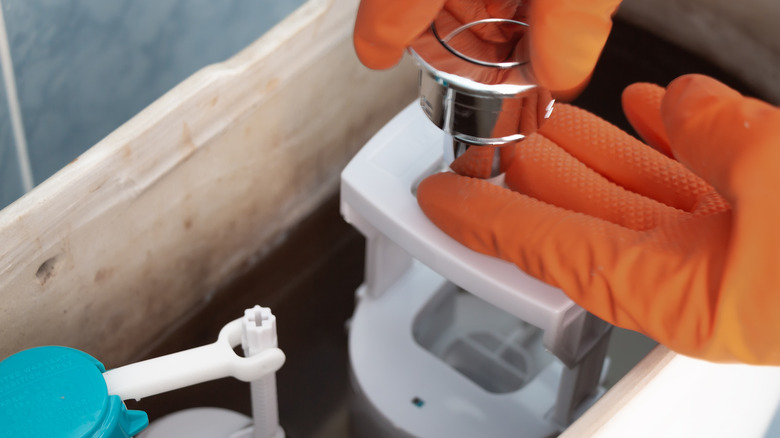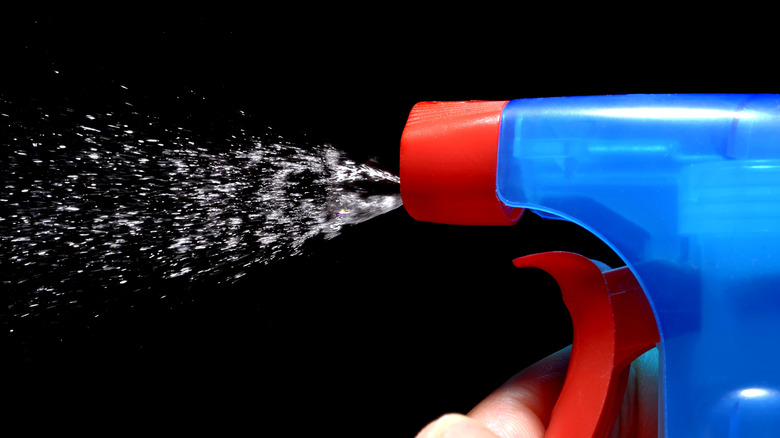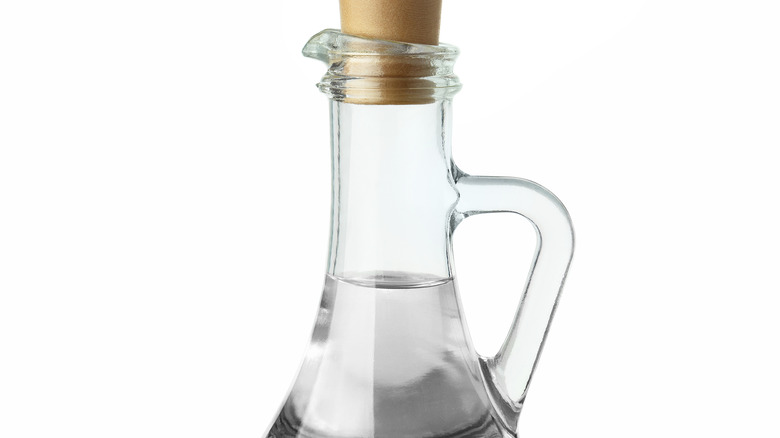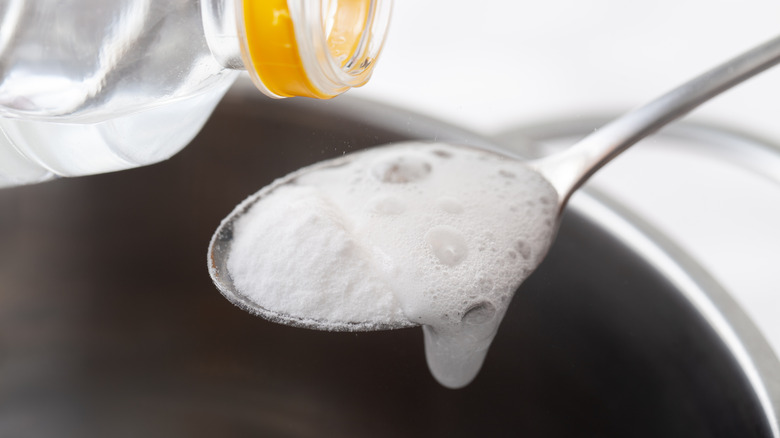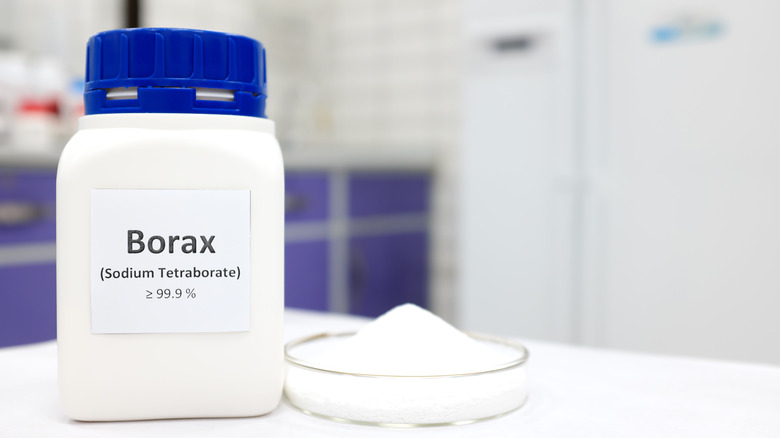8 Easiest Ways To Clean Your Toilet Tank
We may receive a commission on purchases made from links.
Cleaning the toilet bowl is on our regular to-do list, but what about the good-ole forgotten toilet tank — the upper part of the porcelain throne is what allows the toilet to flush! While we may not notice it (okay, until it runs, that is!), we can't forget that a well-maintained tank may contribute to its longevity and ward off the long-term mineral deposits and build-up that can occur if left uncleaned, according to Angi.
Now, if you're left wondering how often a toilet tank should be scrubbed, you'll be happy to know that The Spruce recommends only two times per year, which is doable with even the busiest of schedules. However, the outlet notes that if you have well water, it's a good idea to clean it up to four times a year.
We know what not to put in a toilet tank! We have found that bleach, fabric softener, and putting Fabuloso in your tank may not be the best idea. Read on to find out the eight easiest (and safe!) ways to make your toilet tank sparkle from the inside.
1. Drain the tank
While you may want to dig in and start cleaning the toilet tank, a few steps are needed prior to that happening. Before you begin, you will want to start by completely draining the water out of the tank. The Spruce advises that you must locate the water valve and turn off the water, remove the lid, and flush the toilet as many times as needed (they say two or three times should do the trick) until the water is completely gone from the tank.
When you remove the lid and put it on the floor, This Old House says it's best to place it on a towel, which is an excellent idea to protect your bathroom floors. Once the water is out, you can assess how dirty the tank is and see if it needs a light scrub or one of the following cleaning mixtures to tackle extra dirty tanks.
2. Use a long scrub brush
It may be that your toilet tank may just need a nice, healthy scrubbing to get it back to its former like-new glory. This Old House says that you can simply scrub the tank's walls with a scrub brush and use a regular sponge to clean the metal parts, ensuring that all rusty areas or build-up are rubbed clean, which shouldn't be too hard of a task to complete.
However, Bob Vila notes that you don't want to use the same scrub brush that you use to clean the toilet bowl for obvious reasons (can we get a collective ewww). They suggest buying a brand new, longer brush with strong brush bristles to clean the toilet tank, which can reach all over the tank, sliding past the metal parts with capabilities to get to those hard-to-reach spots such as the corner and bottom of the tank.
3. Clean the metal parts
After you are finished scrubbing the walls, corners, and the bottom of the toilet tank, it's essential not to forget to clean the metal parts inside the toilet tank as well. "While the water in the tank is usually clean, the metal parts can corrode and rust, and the interior of the tank can get discolored," says Home Depot bath fixtures merchant Patty Stoffelen to Martha Stewart. "Cleaning your toilet tanks helps prevent the build-up of rust and mildew."
Bob Vila explains that you do not want to spray the parts directly with the cleaner, either. Instead, they advise that you spray a sponge with a watered-down cleaning mixture first to ensure that the parts are not ruined. It's not a bad idea to check what the parts are made of to see what type of cleaner to use, because pure bleach could easily damage the metal parts.
4. Try a disinfectant cleaner
The Spruce recommends using a disinfectant cleaner to clean the inside of your toilet's tank; however, the outlet clarifies not to spray the metal parts as doing this could cause them to be ruined (we don't want that!). Bob Vila also suggests this method, saying you can use your favorite disinfectant to clean the tank and rid it of bacteria. Both outlets say that you can leave the spray on for around 10 minutes and up to fifteen minutes to really get the job done.
Ken's Plumbing is also a fan of using a disinfectant; however, the company strongly advises that homeowners or renters read the label to ensure that it is safe for your toilet tank, which we also recommend doing for anything you are cleaning. The company also suggests that you not use hydrogen peroxide or oxygenated bleach products due to unsafe fumes they could cause.
5. Soak in distilled white vinegar
Distilled white vinegar is an excellent cleaning product to have on hand. It can clean the inside of your toilet bowl, other bathroom surfaces, including a showerhead, and thankfully the inside of your toilet tank.
According to Ken's Plumbing, vinegar is an excellent solution to ridding a toilet tank of excess mineral build-up. The company explains that you can fill the tank with vinegar and let it penetrate the tank, leaving it to sit overnight. The best part is that you can wake up to a clean tank by morning, and who wouldn't love that — no scrubbing needed. We love the sound of that! Additionally, lemon juice can be used instead if you don't like the smell of vinegar. The Pink Plumber says that lemon juice can help remove hard water deposits, but be warned not to dilute with vinegar because then this method won't work.
6. Use vinegar and baking soda
If you loathe the smell of vinegar, there is another option that you can do to get your toilet tank clean. According to Love To Know, sometimes time is of the essence. In that case, the outlet suggests a brilliant combination that consists of 1 cup of vinegar and another top powerhouse cleaner: 1/2 cup of baking soda, along with 2 tablespoons of dish soap such as Dawn. Spread the mixture inside the tank and wait for an hour before scrubbing it clean. We are also a fan of baking soda to clean other top items, such as laundry or your kitchen drain, even going so far as helping to unclog it.
Ken's Plumbing notes bleach is an alternative option; however, we advise against it as it can ruin the internal metal parts of your toilet's tank — and who wants corroded parts, which would be another headache altogether?
7. Use Borax, vinegar, and essential oils
Borax is another multi-purpose product. It can get rid of ants, clean a garbage disposal, and even clean your laundry. Yarrow Plumbing Services suggests another popular method: using Borax, most known for cleaning everything from rust to mold stains. This mixture consists of 3/4 cup of Borax, 1 cup of vinegar, and essential oils to clean your toilet tank; use six drops of lemon essential oil and nine drops of lavender. However, we think that you can use the essential oil that you desire! Don't forget your gloves and water. You will then mix everything together in a spray bottle, spray down the tank, wait overnight (or up to four hours), and rinse for a clean tank.
A similar mixture can also be used for your toilet bowl if you are on the hunt for something natural. Bob Vila advises combining 2 cups of baking soda and 1/2 cup of 20% vinegar (not to be confused with regular vinegar). Then add about 1 teaspoon of essential oil that disinfects (think pine or tea tree oil) and mix it in a glass bowl to forgo any unpleasant reactions from the essential oils.
8. Purchase toilet tank cleaners
One way to clean the inside of your toilet tank is simply by purchasing products to do the job. However, we have found it's better to forgo the little blue tablets for your tank, per Pipe Wrench Plumbing, Heating & Cooling.
Thankfully, there are several other options on the market, including the Instant Power 1806 Toilet Tank Cleaner, which removes build-up from hard water, calcium, and rust. One Amazon reviewer had a slew of toilets with dirty tanks and was thoroughly impressed with the product. "The directions said to use half a bottle but having three toilets to work on, I used a third of the bottle," they explained. "About half an hour later, I checked to see if it was doing anything at all and was shocked. The tank was clean! I don't mean that the tank was cleaner, but it was clean! I really couldn't believe it."
